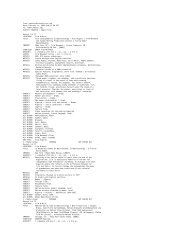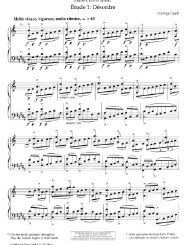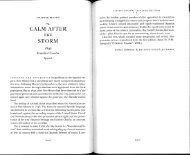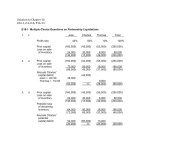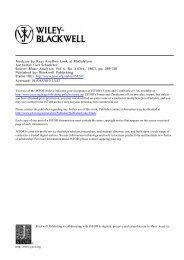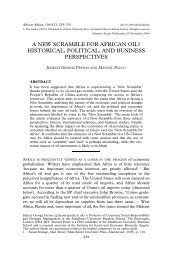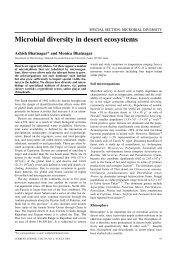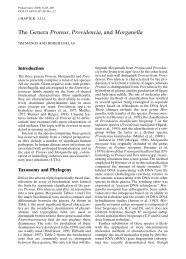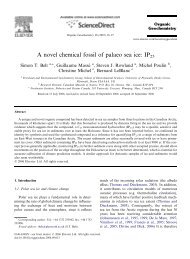The Genus Serratia
The Genus Serratia
The Genus Serratia
You also want an ePaper? Increase the reach of your titles
YUMPU automatically turns print PDFs into web optimized ePapers that Google loves.
238 F. Grimont and P.A.D. Grimont CHAPTER 3.3.11<br />
Bouvet, O. M. M., Lenormand, P., Grimont, P. A. D. 1989.<br />
Taxonomic diversity of the D-glucose oxidation pathway<br />
in the Enterobacteriaceae. International Journal of Systematic<br />
Bacteriology 39:61–67.<br />
Braun, V., Günter, H., Nuess, B., Tautz, C. 1985. Hemolytic<br />
activity of <strong>Serratia</strong> marcescens. Archives of Microbiology.<br />
141:371–376.<br />
Breed, R. S., Breed, M. E. 1924. <strong>The</strong> type species of the genus<br />
<strong>Serratia</strong>, commonly known as Bacillus prodigiosus. Journal<br />
of Bacteriology 9:545–557.<br />
Breed, R. S., Breed, M. E. 1927. <strong>The</strong> genus <strong>Serratia</strong> Bizio.<br />
Zentralblatt für Bakteriologie, Parasitenkunde und<br />
Infektionskrankheiten, Abt. 2, 71:435–440.<br />
Breed, R. S., Murray, E. G. D., Hitchens, A. P. 1948. Bergey’s<br />
manual of determinative bacteriology. 6th ed.<br />
Baltimore, Williams & Wilkins.<br />
Breed, R. S., Murray, E. G. D., Smith, N. R. 1957. Bergey’s<br />
manual of determinative bacteriology. 7th ed. Baltimore,<br />
Williams & Wilkins.<br />
Brigden, C. J., Furn, S., Wilkinson, S. G. 1985. Structural<br />
studies of neutral polymers isolated from the<br />
lipopolysaccharides of <strong>Serratia</strong> marcescens O6 (strain C.<br />
D. C. 862-57) and O12 (C.D.C. 6320-58). Carbohydrate<br />
Research 139:298–301.<br />
Brigden, C. J., Wilkinson, S. G. 1983. Lipopolysaccharide<br />
from the O14 type strain of <strong>Serratia</strong> marcescens: structural<br />
studies of a polymeric fraction. Carbohydrate<br />
Research 115:183–1901.<br />
Brigden, C. J., Wilkinson, S. G. 1985. Structural studies of<br />
acidic glucomannans from strains of <strong>Serratia</strong> marcescens<br />
O14 and O6. Carbohydrate Research 138:267–276.<br />
Brisou, J., Cadeillan, J. 1959. Etude sur les <strong>Serratia</strong>. Bulletin<br />
de l’Association des Diplomés de Microbiologie de la<br />
Faculté de Pharmacie de Nancy. 75:34–39.<br />
Brisou, B., Richard, C., Lenriot, A. 1972. Intérêt taxonomique<br />
de la recherche de la β-xylosidase chez<br />
les Enterobacteriaceae. Annales de l’Institut Pasteur<br />
123:341–347.<br />
Bucher, G. E. 1959. Bacteria of grasshoppers of western<br />
Canada. Journal of Insect Pathology 1:391–405.<br />
Bucher, G. E. 1960. Potential bacterial pathogens of insects<br />
and their characteristics. Journal of Insect Pathology<br />
2:172–195.<br />
Bucher, G. E. 1963a. Nonsporulating bacterial pathogens.<br />
117–147. Steinhaus, E. A. (ed.) Insect pathology. An<br />
advanced treatise, vol. 2. New York. Academic Press.<br />
Bucher, G. E. 1963b. Transmission of bacterial pathogens by<br />
the ovipositor of a hymenopterous parasite. Journal of<br />
Insect Pathology 5:277–283.<br />
Bucher, G. E., Stephens, J. M. 1959. Bacteria of grasshoppers<br />
of western Canada. Journal of Insect Pathology 1:356–<br />
373.<br />
Burnside, C. E. 1928. A septicemic condition of adult bees.<br />
Journal of Economic Entomology 21:379–386.<br />
Cabrera, H. A. 1969. An outbreak of <strong>Serratia</strong> marcescens and<br />
its control. Archives of Internal Medicine 123:650–655.<br />
Caldis, P. D. 1927. Etiology and transmission of endosepsis<br />
(internal rot) of the fruit of the fig. Hilgardia 2:287–328.<br />
Capponi, M., Sureau, P., Le Minor, L. 1956. Contribution á<br />
l’étude des salmonelles du Centre-Vietnam. Bulletin de<br />
la Société de Pathologie Exotique. 49:796–801.<br />
Carter, G. R. 1973. Diagnostic procedures in veterinary<br />
microbiology. Springfield, Illinois. Charles C. Thomas..<br />
Cate, J. C. 1972. Isolation of <strong>Serratia</strong> marcescens from stools<br />
with an antibiotic plate. 763–764. Hejzlar, M., Semonsky,<br />
M. and Masák, S. (ed.) Advances in antimicrobial and<br />
antineoplastic chemotherapy. Progress in research and<br />
clinical application. Proceedings of the 7th International<br />
Congress of Chemotherapy, vol. 1/2: Munich, Berlin,<br />
Vienna, Urban & Schwarzenberg.<br />
Colwell, R. R., Mandel, M. 1965. Adansonian analysis and<br />
deoxyribonucleic acid base composition of <strong>Serratia</strong><br />
marcescens. Journal of Bacteriology 89:454–461.<br />
Combe, E. 1933. Etude comparative de trois bactéries chromogènes<br />
à pigment rouge: <strong>Serratia</strong> marcescens Bizio<br />
(Bacillus prodigiosus Flügge), <strong>Serratia</strong> kiliensis Comité<br />
S.B.A. (Bacterium h Breunig), <strong>Serratia</strong> esseyana n. sp.<br />
Combe (Bacille rouge d’Essey Lasseur). University of<br />
Nancy. Nancy, France.<br />
Daschner, F. D. 1980. <strong>The</strong> epidemiology of <strong>Serratia</strong> marcescens.<br />
187–196. von Graevenitz, A., and Rubin, S. J. (ed.)<br />
<strong>The</strong> genus <strong>Serratia</strong>. Boca Raton, CRC Press.<br />
Dauenhauer, S. A., Hull, R. A., Williams, R. P. 1984. Cloning<br />
and expression in Escherichia coli of <strong>Serratia</strong> marcescens<br />
genes encoding prodigiosin biosynthesis. Journal of Bacteriology<br />
158:1128–1132.<br />
Davis, B. R., Woodward, J. M. 1957. Some relationships of<br />
the somatic antigens of a group of <strong>Serratia</strong> marcescens<br />
cultures. Canadian Journal of Microbiology<br />
3:591–597.<br />
Denis, F. A., Blanchard, P. 1975. Enquête sur les porteurs<br />
intestinaux de <strong>Serratia</strong>. Nouvelle Presse Médicale<br />
4:2114–2115.<br />
Deom, J., Mortelmans, J. 1953. Etude d’une souche<br />
pathogène de <strong>Serratia</strong> marcescens. Revue d’Immunologie<br />
17:394–398.<br />
Ding, M. J., Williams, R. P. 1983. Biosynthesis of prodigiosin<br />
by white strains of <strong>Serratia</strong> marcescens isolated from<br />
patients. Journal of Clinical Microbiology 17:476–480.<br />
Duran-Reynals, F., Clausen, H. J. 1937. A contagious tumorlike<br />
condition in the lizard (Anolis equestris) as induced<br />
by a new bacterial species, <strong>Serratia</strong> anolium (sp. n.).<br />
Journal of Bacteriology 33:369–379.<br />
Ehrenberg, C. G. 1848. Communication presented at the plenary<br />
session of the Royal Prussian Academy of Sciences,<br />
October 26. 346–362. Akademie der Wissenschaften zu<br />
Berlin.<br />
Eisenberg, J. 1886. Bakteriologische Diagnostik. Hülfs-<br />
Tabellen beim Praktischen Arbeiten. Hamburg,<br />
Leopold Voss.<br />
El Sanoussi, S. M., El Sarag, M. S. A., Mohamed, S. E. 1987.<br />
Properties of <strong>Serratia</strong> marcescens isolated from diseased<br />
honeybee (Apis mellifera) larvae. Journal of General<br />
Microbiology 133:215–219.<br />
Ewing, W. H. 1963. An outline of nomenclature for the family<br />
Enterobacteriaceae. International Bulletin of Bacteriological<br />
Nomenclature and Taxonomy 13:95–110.<br />
Ewing, W. H. 1986. Edwards and Ewing’s Identification of<br />
Enterobacteriaceae. 4th ed. Elsevier. New York.<br />
Ewing, W. H., Davis, B. R., Fife, M. A. 1972. Biochemical<br />
characterization of <strong>Serratia</strong> liquefaciens and <strong>Serratia</strong><br />
rubidaea. Atlanta, Center for Disease Control.<br />
Ewing, W. H., Davis, B. R., Johnson, J. G. 1962. <strong>The</strong> genus<br />
<strong>Serratia</strong>: Its taxonomy and nomenclature. International<br />
Bulletin of Bacteriological Nomenclature and Taxonomy<br />
12:47–52.<br />
Ewing, W. H., Davis, B. R., Reavis, R. W. 1959. Studies on<br />
the <strong>Serratia</strong> group. Atlanta, Center for Disease Control.<br />
Ewing, W. H., Davis, B. R., Fife, M. A., Lessel, E. F. 1973.<br />
Biochemical characterization of <strong>Serratia</strong> liquefaciens<br />
(Grimes and Hennerty) Bascomb et al. (formerly Enterobacter<br />
liquefaciens) and <strong>Serratia</strong> rubidea (Stapp) comb.



